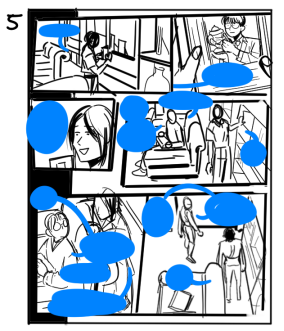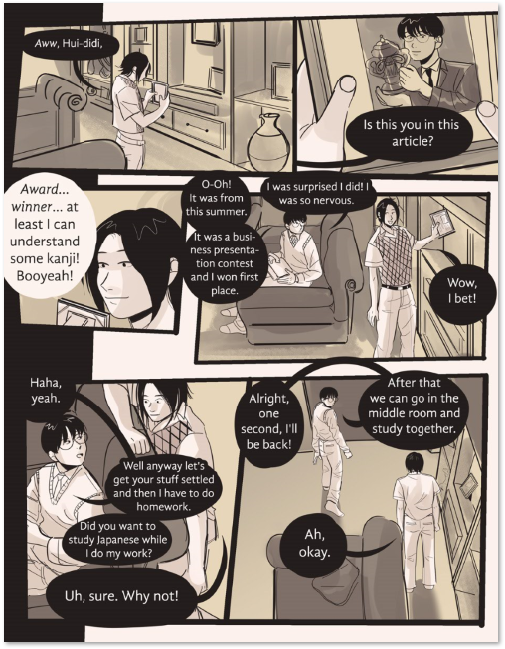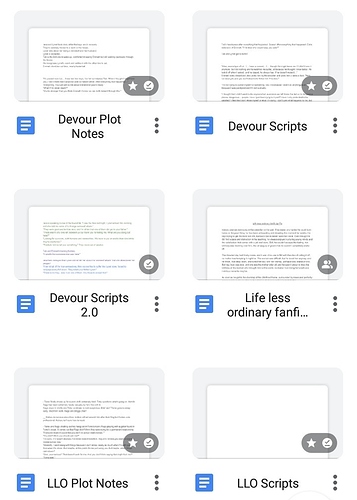I used to dive straight into the thumbnailing/scripting phase at the same time but after a few too many false starts on some recent chapters I've started doing a little more prep work.
I've got at least two word files for each comic. One with the "novel" version of the story and one for quick scene ideas and dialogue that I wanna jot down. Sometimes the random scenes don't actually make it in but they're there for use just in case.
I always plan for the thumbnails to be the last spot for changes but sometimes the layout and content of the panels needs changing and sometimes little tweaks to the final word bubbles as well. Some dialogue just sounds better in a novel vs on a comic page.
I find writing standard scripts to be a bit confusing.
So what I do is I start out with brainstorming a plot and replay it in my head over and over again. Once I figured out what I want, I will write a thumbnail/script hybrid by hand. Then I tend to edit the thumbnail by adding and removing pages if needed.
I am going to recommend not winging a series. I once did that and it can get annoying down the line because you will mess up your pacing. I got to a point where I didn't know how to end the series because it was all a jumbled mess in my head.
I have a bit of an odd way for concepting because I often come up with comic concepts out of order and WAY before they come up in the story. I often doodle these on paper so i don't forget it
What I started doing with my comic is more rough bullet points of plot details in a Physical notebook, I don't bother with detailing every pose unless it has plot significance. I'll script out dialog scenes that need a bit more attention to detail and thought, particularly emotional sections. I find doing it this way allows me to keep the story straight, keep ideas, but still allow for flexibility in my art.
all of the little concept drawings I tape into the back of the notebook, almost like a 'mood board' of sorts.
I'm sure all of this could be done on a word doc but I like having a physical book, it allows me to write things down whether my computers available or not.
I have to agree with not winging it, I learned this lesson part way through my current comic on Tapas called TLC5 around the 6th chapter or so, as the first major arch was wrapping up
I’ve never written a script even for my long form stuff. I write out a pretty detailed outline and plan out the beats but I write in all of my dialogue entirely in the thumbnailing stage.
I’ve never really enjoyed the process of scripting and if I’m doing al the work myself it only really needs to be legible to ME so it’s an unnecessary step in the process that I’m extremely happy I can do without.
I also think it’s a good method for me because I plan out the layouts with the speech balloons included and this really helps me paint a full picture of what’s happening on a page before i make the mistake of trying to add too much dialogue into a key panel or something.
I do my scripts pretty much in the same fashion that @rokudoku does theirs; it takes a lot of guess work out of thumbnailing, planning when I do it this way...the only thing I have to do is draw/ink/color/letter the damn thing.
I've only had a few instances where I've deviated from what I originally planned, but for the most part I "stick to the script".
I had to learn to write ~industry ready~ scripts, but I VERY QUICKLY found it overkill if I'm working by myself.
Normally I'll start out with a very rough scene-by-scene breakdown - something like a few bullet points (major thing that happens in the scene, things I need to show, jokes, etc). Then I do digital thumbnails alongside a text box that contains the dialogue and maybe some panel descriptions/details. If I'm having issues forming the scene in my head, I will "write into" the scene, where I would write it out as if it's in novel format. It allows me to write extra dialogue/write several different versions of the scene relatively quickly and have the characters do/say/emote extra things so that I can then streamline them into a final product.
I do it for myself because it reduces my stress and my workload.
I can get a bunch of my pages panelled out at the beginning of the month and not have to worry about it later. Also I don't have to stare at a blank page without knowing what it's going to be already.
I also know that I tend to reuse panel layouts a lot (I keep them really simple) so being able to look at the whole chapter and check for that is good. I pick out my word bubble placement at the thumbnail stage too.
Blah, blah, blah.  Basically, for myself, I find it be a vital step in my process.
Basically, for myself, I find it be a vital step in my process.
I don't see the point of doing both a detail script AND thumbnails, unless you work with someone. But I think it can help a lot in the long time,
Without working the plot at first, it inevitably ends up unfinished as nothing makes sense anymore and the drawing process become difficult...
Still my writing is very rough (usually I can't get the dialogues alright so I know I WILL have to rework like 5 times)
I like to use adhesive notes so that I may work the timeline of the story like some jigsaw puzzle and place each scene and not forgetting one in the proces (and adding one is always easier that way xD
So there are "action" notes, "plot information" notes, and I put them on the different settings of the story.
Then, I draw thumbnails of each panel until pages are composed to my liking.
Then, I cheer up because I was so productive !
Aaaaand when 6 months later I'm actually on that part of the story and reopened my thumbnails, I hate my past self because I can't distinguish whatever it was I draw that f**** day xD
Usually I have a basic outline in mind for what I want to happen. Less like a "here is what is in every panel" and more of a "here are the main story points and a few beats from each part so I stay on track". Then I do thumbnails, with vague ideas of what the dialogue is going to be (bc w a comics medium i find it best to be flexible with that for the sake of visuals). Then once I get the art done I'll set up what is actually being said. Nothing too fancy really.
I mean I sorta do, through doodles and sketches. I compile crude sketches and rearrange them until I can figure out where I'm really going with a scene. I don't write things down in script for with the exception of funny little dialogue exchanges I'd like to remember. Because if I sit down to write a script it turns into a novel. And I don't mean that figuratively, because it writes and reads as a novel
Back when I used to write cartoon strips for someone else to draw, I used to write scripts in the format that Rokodoku demonstrates at the top of the thread. Now I'm both writing and drawing, I no longer need to bother with formal scripts and tend to rough out a layout in a notebook and show how the dialogue falls in each panel. usually I know who is going to be in each panel so I leave it there. A big cast, or an interesting visual idea can be shown inthe same way by just writing who is there or sketching the important pose. Example below, complete with failed punchline crossed out and replacement lower tier on the previous page.
The finished version of the strip can be found here:
I think it's definitely a good idea to write a script down with a comic with a plot, although everyone has a certain process that they're the most comfortable with, so hopefully you'll figure out what way you want to do it. I've been working on my webcomic for a few years now and it just helps to have those scripts and outlines, because I still find myself changing things around or coming up with new ideas, and it's good to have the scripts as a reference of the timeline of the story as well. With the webcomic I've been working on, in the beginning I planned out a basic outline of what I want to happen in the story, and originally I didn't have an ending planned. Now that the story is coming together more solidly, I usually get ideas for different chapters and start writing out the script. My scripts are very loose and I write them immediately as I get the idea for them, so they're sort of like a steam of consciousness and not really formatted in a pretty way.  I usually write the actions in parenthesis, and then the dialogues. I don't differentiate which character is speaking because it takes up too much time, and I try my best to get that raw idea of what I'd imagined in my head onto the document. After the rough script, I organize how many panels I want each page (adding panel numbers into the script) and then figure out where I feel is the best place to end that page. Afterwards, I work on the thumbnail, and then the final page.
I usually write the actions in parenthesis, and then the dialogues. I don't differentiate which character is speaking because it takes up too much time, and I try my best to get that raw idea of what I'd imagined in my head onto the document. After the rough script, I organize how many panels I want each page (adding panel numbers into the script) and then figure out where I feel is the best place to end that page. Afterwards, I work on the thumbnail, and then the final page.
 2
2
 2
2
 2
2




